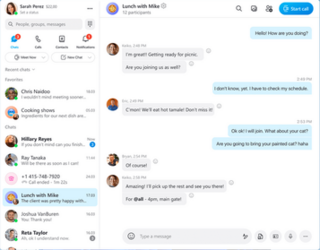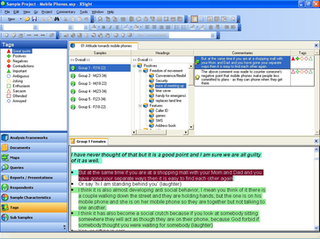
Microsoft Excel is a spreadsheet editor developed by Microsoft for Windows, macOS, Android, iOS and iPadOS. It features calculation or computation capabilities, graphing tools, pivot tables, and a macro programming language called Visual Basic for Applications (VBA). Excel forms part of the Microsoft 365 suite of software.

Microsoft Office, or simply Office, is a family of client software, server software, and services developed by Microsoft. It was first announced by Bill Gates on August 1, 1988, at COMDEX in Las Vegas. Initially a marketing term for an office suite, the first version of Office contained Microsoft Word, Microsoft Excel, and Microsoft PowerPoint. Over the years, Office applications have grown substantially closer with shared features such as a common spell checker, Object Linking and Embedding data integration and Visual Basic for Applications scripting language. Microsoft also positions Office as a development platform for line-of-business software under the Office Business Applications brand.

Microsoft Outlook is a personal information manager software system from Microsoft, available as a part of the Microsoft 365 software suites. Though primarily being popular as an email client for businesses, Outlook also includes functions such as calendaring, task managing, contact managing, note-taking, journal logging, web browsing, and RSS news aggregation.

Skype is a proprietary telecommunications application operated by Skype Technologies, a division of Microsoft, best known for VoIP-based videotelephony, videoconferencing and voice calls. It also has instant messaging, file transfer, debit-based calls to landline and mobile telephones, and other features. It is available on various desktop, mobile, and video game console platforms.

Desktop search tools search within a user's own computer files as opposed to searching the Internet. These tools are designed to find information on the user's PC, including web browser history, e-mail archives, text documents, sound files, images, and video. A variety of desktop search programs are now available; see this list for examples. Most desktop search programs are standalone applications. Desktop search products are software alternatives to the search software included in the operating system, helping users sift through desktop files, emails, attachments, and more.

Microsoft OneNote is a note-taking software developed by Microsoft. It is available as part of the Microsoft 365 suite and since 2014 has been free on all platforms outside the suite. OneNote is designed for free-form information gathering and multi-user collaboration. It gathers users' notes, drawings, screen clippings, and audio commentaries. Notes can be shared with other OneNote users over the Internet or a network.

A crash reporter is usually a system software whose function is to identify reporting crash details and to alert when there are crashes, in production or on development / testing environments. Crash reports often include data such as stack traces, type of crash, trends and version of software. These reports help software developers- Web, SAAS, mobile apps and more, to diagnose and fix the underlying problem causing the crashes. Crash reports may contain sensitive information such as passwords, email addresses, and contact information, and so have become objects of interest for researchers in the field of computer security.
ATLAS.ti is a computer-assisted qualitative data analysis software that facilitates analysis of qualitative data for qualitative research, quantitative research, and mixed methods research.
In the social sciences, coding is an analytical process in which data, in both quantitative form or qualitative form are categorized to facilitate analysis.
NVivo is a qualitative data analysis (QDA) computer software package produced by Lumivero. NVivo is used across a diverse range of fields, including social sciences such as anthropology, psychology, communication, sociology, as well as fields such as forensics, tourism, criminology and marketing.

XSight was a software for qualitative data analysis. Its last version was released in 2006, which was supported until January 2014. Developed by QSR International for qualitative data analysis (QDA), it is a tool for researchers or individuals who are undertaking short term qualitative research analysis on projects involving non-numerical data. Qualitative research can encompass business intelligence, marketing research or data analysis. It was superseded by NVivo 10 for Windows, which offers equivalent functionality with greater flexibility and enables researchers to work with more data types likes PDFs, surveys, images, video, audio, web and social media content.
Computer-assistedqualitative data analysis software (CAQDAS) offers tools that assist with qualitative research such as transcription analysis, coding and text interpretation, recursive abstraction, content analysis, discourse analysis, grounded theory methodology, etc.
MAXQDA is a software program designed for computer-assisted qualitative and mixed methods data, text and multimedia analysis in academic, scientific, and business institutions. It is being developed and distributed by VERBI Software based in Berlin, Germany.

Citavi is a program for reference management and knowledge organization for Microsoft Windows published by Swiss Academic Software in Wädenswil, Switzerland. Citavi is very widely used in Germany, Austria, and Switzerland, with site licenses at most universities, many of which offer training sessions and settings files for Citavi.
QDA Miner is mixed methods and qualitative data analysis software developed by Provalis Research. The program was designed to assist researchers in managing, coding and analyzing qualitative data.
Developed by Tragon Corporation in 1974, Quantitative Descriptive Analysis (QDA) is a behavioral sensory evaluation approach that uses descriptive panels to measure a product's sensory characteristics. Panel members use their senses to identify perceived similarities and differences in products, and articulate those perceptions in their own words. Sensory evaluation is a science that measures, analyzes, and interprets the reactions of the senses of sight, smell, sound, taste, and texture (or kinesthesis) to products. It is a people science; i.e., people are essential to obtain information about products.
Cassandre is a free open source software for computer assisted qualitative data analysis and interpretation in humanities and social sciences. Although it refers, like other CAQDAS-software, to Grounded Theory Method, it also allows to conduct discourse analysis or quantitative content analysis. The software is designed as a server to support collaborative work. Formerly focused on semi-automatic coding, it now provides diaries assisting qualitative analysis.

KH Coder is an open source software for computer assisted qualitative data analysis, particularly quantitative content analysis and text mining. It can be also used for computational linguistics. It supports processing and etymological information of text in several languages, such as Japanese, English, French, German, Italian, Portuguese and Spanish. Specifically, it can contribute factual examination co-event system hub structure, computerized arranging guide, multidimensional scaling and comparative calculations. Word frequency statistics, part-of-speech analysis, grouping, correlation analysis, and visualization are among the features offered by KH Coder.

Quirkos is a CAQDAS software package for the qualitative analysis of text data, commonly used in social science. It provides a graphical interface in which the nodes or themes of analysis are represented by bubbles. It is designed primarily for new and non-academic users of qualitative data, to allow them to quickly learn the basics of qualitative data analysis. Although simpler to use, it lacks some of the features present in other commercial CAQDAS packages such as multimedia support. However, it has been proposed as a useful tool for lay and participant led analysis and is comparatively affordable. It is developed by Edinburgh, UK based Quirkos Software, and was first released in October 2014.
Marilyn Gray Richards is an Australian social scientist and writer who, with computer scientist Tom Richards, developed the software analysis packages NUD*IST and NVivo.










